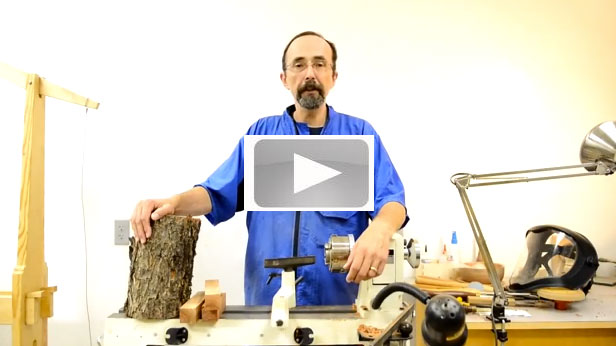Turning a Bird Seed Scoop
by Curtis Turner
Round Rock, TX
Note: click on any picture to see a larger version.
Scoop
Recently, my son and I built a small bird feeder. The small size of this feeder required a small scoop to refill the seed. So, for this month's article, we are going to make a bird seed scoop.
This is a good project for your first end grain hollowing exercise. This project can be scaled up to suit your needs. I am happy to give full credit to Richard Raffan for this technique. I learned how to make this project years ago, by watching one of Richard's early videos.
I highly recommend
Richard's books and videos.
He has a no nonsense approach to turning that I find enlightening.
I used locally harvested plum for this scoop. This was my first time to turn plum and found it surprisingly dense. Interestingly, the color reminds me of mesquite. However, for this project, just about any wood could work.
I split this blank from a small log and then cut it into a 2" square x 6" long blank on a bandsaw. I then used a spindle roughing gouge to rough turn the blank. After cutting a small tenon, I mounted the spindle in the
Easy Chuck.
I then re-trued the blank. I marked out transition lines with a skew. These lines represent key points in the scoop where transitions occur. I then used the skew to further shape the scoop. I left the handle oversized to help provide support during the hollowing operation.
I removed the tail stock in preparation for hollowing the cup after the exterior of the cup was refined.
Hollowing
Hollowing for the first time can be a bit nerve racking. It requires cutting directly into tough end grain fibers. Perhaps the most challenging part of hollowing is turning blind. By that I mean, turning in an enclosed space where you cannot see the tool cutting. Hollowing is done mostly by feel. You should reduce the speed of the lathe appropriate for the turning size. The tool rest should be positioned at the correct height and as close to the work as reasonably possible. The tool, of course, should be very sharp. You should proceed carefully. It is also important to not extend the tool too far over the tool rest. Over extending the tool will cause the tool to bounce and chatter typically resulting in a catch or an unplanned dismounting of your turning. Also, overly aggressive turning will result in the same issues.
I used a small spindle gouge to back hollow the cup.
I then used a small round nose scraper to refine the interior of the cup.
It would be acceptable to hollow the cup using any manner of small hollowing tools. You could even use a drill chuck and bit to hollow out the bulk.
I then replaced the tail stock and moved the live center into the cup end of the blank.
This was done to provide more support while I completed working on the handle.
Then I continued to refine the handle using a variety of skews.
Completing the Scoop
I then sanded the scoop while it was on the lathe. I did not go for a highly refined piece since this will be used as bird seed scoop, by my 7 year old son. I then trimmed the end of the handle down to a small
tenon about 1/4" in diameter. Finally, I cut the scoop off with a small flexible saw.
I removed the Easy Chuck and replaced it with a shop made sanding disk.
I carefully sanded away a portion of the cup starting with the outer rim. I felt it was not necessary apply a finish to this scoop.
My son now enjoys using his own scoop to refill his bird feeder.
I am sure you can come up with numerous uses for several scoops.
CLICK BELOW to see the video of how the Bird Seed Scoop was made

Curtis Turner: Turning a Wooden Scoop
Curtis is a former President of
Central Texas Woodturners, a member of the
American Association of Woodturners, and a member of
Fine Woodworkers of Austin. Curtis teaches and demonstrates nationally for Lie-Nielsen Toolworks. He also teaches for TechShop. He owns a studio where he teaches and works. Curtis lives in Central Texas with his wife and four young children. Take a look at his website at
www.curtisturnerstudio.com or visit his
Instagram: tx_planes.
